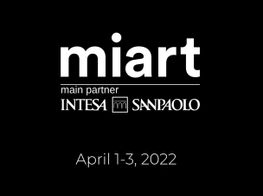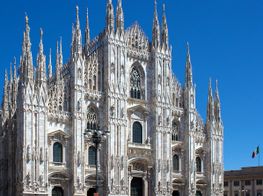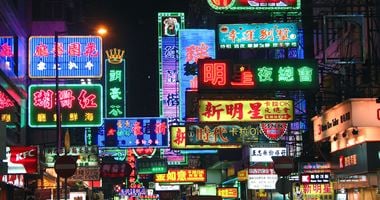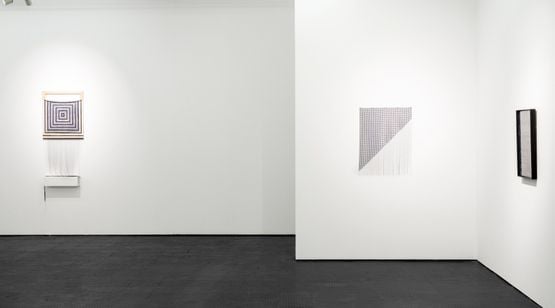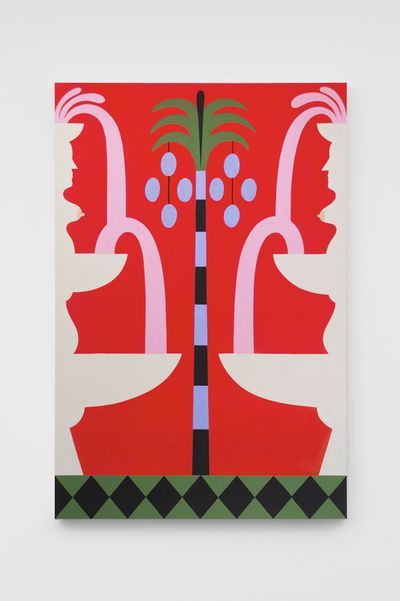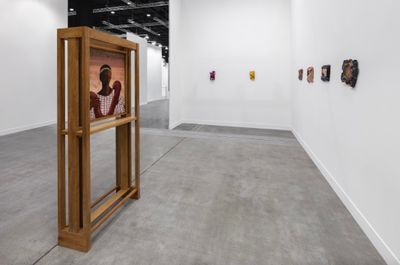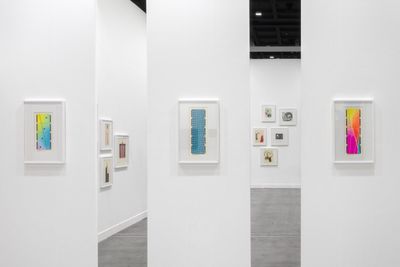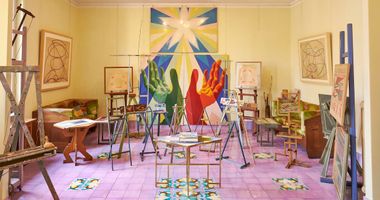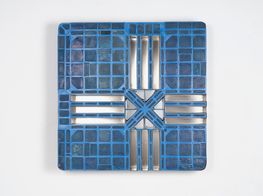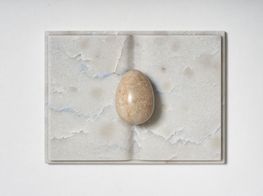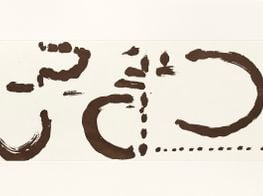miart 2022: Artist Highlights
Ocula Magazine was on the ground in Milan to present some of the artist highlights at miart (1–3 April 2022), Italy's international modern and contemporary art fair.
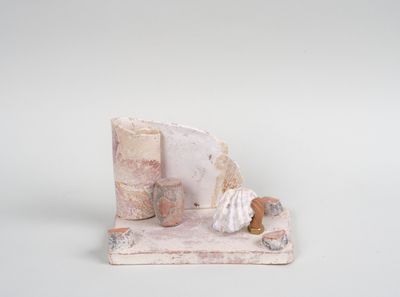
Leelee Chan, Prologue (2021). Tang dynasty (618-907) Chinese pottery fragment, found seashell, brass hex nuts, clay, pigments. 11.5 x 17 x 9 cm. Courtesy the artist and Klemm's, Berlin.
Leelee Chan at Klemm's
Known for using found materials like plastic pallets to create minimalist sculptures that magnify the enigmatic textures of time, Leelee Chan first began working with found ceramics in 2020.
Chan, whose 2020 BMW Art Journey explored mining traditions across Europe and Mexico, was prompted by her participation in Up Close – Hollywood Road (30 May–27 June 2020), an exhibition organised by curators Hilda Chan and Iven Cheung across four galleries on Hollywood Road, Hong Kong's second oldest street and traditional antiques marketplace.
The artist grew up around her parent's antiques business, which sold the kind of ancient pottery figures that Chan resurrected in the 'Present Relics' series (2020), shown at Bonnie Lai Antiquities. For Performer #1 (2020), a broken Ming dynasty head poised on a delicate black metal stand is adorned with a seashell bonnet topped with a yellow plastic flower.
Another performer, Performer #4 (2021), took centre stage at Klemm's booth at miart, alongside Prologue (2021), a surrealist architectural composition composed of a ceramic base and a curl for a wall, in which a small hand supported by a brass hex nut holds up a white seashell.

Bonolo Kavula at SMAC Gallery
Bonolo Kavula's compositions exude a palpable presence that speaks to the intensive and focused labour that went into making each work.
Circular pieces of shweshwe fabrics cut using a hole punch are arranged according to their colours across a delicate grid of thread strands, creating colour blocks and geometric patterns, whose lightness as wall hangings is contrasted by the sheer precision of each circle's placement on its fibre scaffold.
Like Dutch wax prints, shweshwe has its origins in European colonialism but has since become a marker of South African culture—a legacy that extends Kavula's concerns with home, belonging, and family that fed into this turn to a material whose re-appropriation defies its origins.
Kavula first presented these shweshwe works in sewedi sewedi, her first solo show at SMAC Gallery in 2021 (6 March–1 May 2021), which paid tribute not only to her maternal grandfather's life's labours as a De Beers miner in Kimberley, but to his losses, including Kavula's mother when the artist was four. On the show, the artist said: 'I recognise that I labour just as my grandfather did, but the kind of work I do liberates me.'
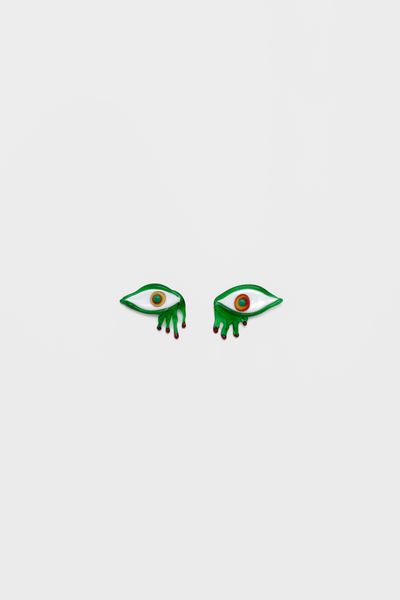
Zoe Williams at Ciaccia Levi
Zoe Williams' Silver O I (2017) was one of the more inconspicuous artworks at miart this year. Positioned on the door to the booth's private room like a peephole was a silver cast of what looked like an anus, offering a welcome return for viewers and sellers alike. (Apparently someone asked about 'the silver cheerio'.)
But the real highlight was Tendresse gaze votives (wrath) (2021), a pair of tearful green eyes cast from Murano glass hung on another wall, like a goblin's votive offering to a god that might appease its wretched heart.
These eyes featured in Williams' latest show with Ciaccia Levi, Tendresse Tendril (11 December–29 January 2021), among glazed ceramic busts of women with chartreuse-green, shoot-like worms coiling out from their eyes, nostrils, and mouths, and amassing around their heads like a Medusa weave, plus a man's head embedded with live moss. (Forms recalling earlier works, like the 2019 ceramic Seething Chartreuse Slipper.)
Narrating it all was the HD video Tendresse, Tendril (Worms' Meat) (2021), with CGI animation bringing those shoots to life, as they consume a gold coin minted from flames. Because what is desire if not a macabre exercise in entropy?

Ketuta Alexi-Meskhishvili at LC Queisser
Ketuta Alexi-Meskhishvili's approach to photography as an expanded field—she studied at Bard College under the likes of Stephen Shore, An-My Lê, and Barbara Ess—enmeshes rigour and wit with the emotive textures of ineffable feels.
Installations like I was no longer seeing myself, shown with Galerie Micky Schubert at Art Basel Statements in 2016, expand the realm of the photographic frame, with selfies hung on the wall partially obscured by patterns printed on sheer curtains, as if to visualise the captured image in an age of digital ubiquity as a portal into a personal space swollen with affect.
At miart, 11 hanging-box frames lined the wall of LC Queisser's booth, each containing two overlapping archival pigment prints on transparent screen film of photographs taken using an iPhone. The superimposition is wave-like, holographic. In Pink Anthurium Pharynx (2020), a single flower seems to hover in the void of a gaping mouth, recalling the artist's 'Quarantine Flowers' Polaroid series made the same year, of flowers taken under lockdown in Germany where florists stayed open.
Among more recent compositions at miart is the side profile of a woman with a Ukrainian flag painted on her cheek; an image the Berlin-based Georgian artist took at a protest against the Russian invasion.
Agostino Iacurci at Ex Elettrofonica
With a style that blends the aesthetics of ancient motifs, folk minimalism, superflat symbolism, and hard-edge whimsical abstraction, Agostino Iacurci honed his craft by painting bold, distinctive murals onto buildings across the world, from Roma Tre University to School Saba in Algeria, and Fubon Art Foundation in Taipei.
'When I was studying engraving at the Fine Arts Academy in Rome I began to make large murals—this was in 2006—which immediately brought me international visibility,' Iacurci recently noted.1 All that travel infused the artist's vocabulary, which distils an explosion of influences with vibrant precision.
Echoes from Salvo and Sottsass to ancient Roman walls infuse recent projects and paintings, including Hotel il Faubourg, a fully functioning hotel created in Milan's Teatro Franco Parenti in 2021 for Hermès, which Iacurci designed with scenographer Gaspard Pinta.
On view at miart was the painting Fontane (2020) and sculpture, Stem (2022)—a Brancusi-esque totem painted pop-red and topped by a potted plant—that extend Iacurci's first solo show with Ex Elettrofonica in Rome, Of my abstract gardening (26 March–28 May 2022), which draws on hortus conclusus, the medieval imagination of paradise as an enclosed garden with a fountain.
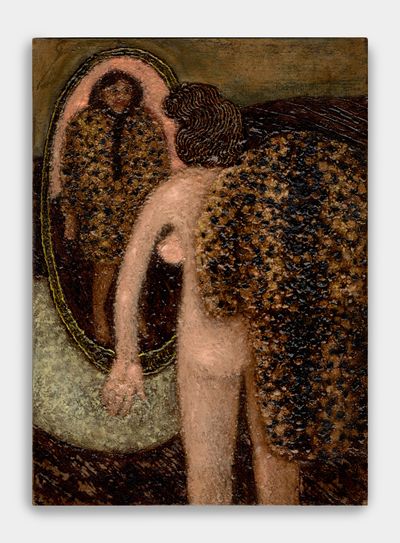
Plum Cloutman at M+B
From afar, Plum Cloutman's small paintings look like pieces from a genre scene by the likes of Pieter Bruegel the Elder, or a background vignette isolated from a Flemish Renaissance miniature—an anachronism that imbues each composition with a heightened sense of incongruity.
Rendered in pastel, watercolour pencil, and oil on paper mounted on board, Sink (2022) is a particularly clever take on the biblical sacred heart. Stylised flames emerge in ornamental lines from a sink to form a perfect ring of fire overhead.
Textures repel rather than entice, thanks to their disarming technicality. Trained in printmaking and painting at the Edinburgh College of Art, where she graduated in 2018, Cloutman has described the space in her compositions—'Set in close quarters, in situations of forced discomfort'—as 'something you look at, rather than something you exist in.'
In Align (2022), a naked woman stands in front of a mirror with a fur coat slung on her shoulder, the dead wildcat's spots punctuated by pockmarks and scratches, only for her reflection to show the coat covering her body.
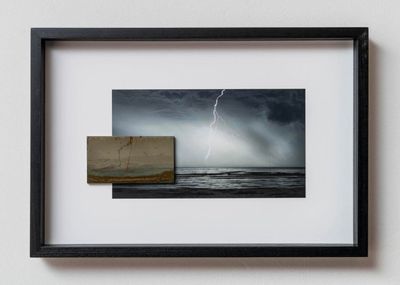
Pamela Diamante at Gilda Lavia
Pietra paesina is a variety of limestone found in the mountain regions of northern Italy that has been collected for centuries because the natural markings and grains make their marbling appear like landscape paintings.
Perhaps the European version of a scholar's rock, the Grand Ducal workshops of Florence developed the use of the stone as artisanal decoration in the 16th century, whether as plaques or incorporated into furniture.
Their draw, writer Roger Caillois suggests, comes from their connection to deep time. 'These images are so perfect that they appear to have been painted, as though nature was able through these simulacrums to portray beneath the earth's surface what exists in the external world.'2
In this era of intensifying climate crisis, Pamela Diamante's series 'Fenomenologia del sublime' (2020) pairs slabs of pietra paesina with markings that match an image of a natural landmark, like a shard of lightning captured as it strikes down over the sea.
Jem Perucchini at Corvi-Mora
Placed front and centre in this Herno Prize-winning booth, where abstract ceramic and aluminium works by Sam Bakewell and Robert Burnier lined the walls, was Tiresia (2021) a standing wooden frame hosting two paintings by Jem Perucchini back-to-back.
Named after a blind Apollonian prophet who apparently spent years as a woman, each painting expresses the figure's mythical duality. On one side, a Black figure with long hair holds a snake coiling around both shoulders like a serpentine burden—a position mirrored in the painting facing the back wall, this time with the figure's hair cut short.
A graduate of the Accademia di Belle Arti di Brera in Milan with an interest in common archetypes, this young Ethiopian-Italian painter's portraits invoke the soft textures of a da Vinci capture, with fleshy edges modulated by pointillist marks that illuminate the background as patterned clothing electrifies the foreground.
These effects are best captured in another work, not shown at the fair, Sbandieratore (notturno) (2021). With echoes of da Vinci's Salvator Mundi (1500), a Black saint holds a staff and a crystal globe that light up the midnight darkness shrouding the scene, as do his eyes.
Luigi Veronesi at 10 A.M. ART
A stunning presentation of works illuminated the trans-disciplinary career of Milanese artist Luigi Veronese.
Among the works were costume designs from 1935 for Oscar Wilde's Salome, and from 1939 for Igor Stravinsky The Soldier's Tale; as well as set designs for productions by Louis Cortese and Leonid Andreyev, all rendered in a style that spoke to Veronesi's turn to Bauhaus at the time. (Of particular note, a character with a basketball for a head.)
A notable influence was László Moholy-Nagy, whose photographic experiments influenced Veronesi's own explorations into avantgarde photography that incorporated photograms, solarisation, and photomontage.
Three astonishing prints from Veronesi's 'Film n.4' series (1940), in which colour, shape, and line play a central role, reveal a vision ahead of its time. In Film n.4 (6), a strip of five frames lined up vertically like a column, host a gradating intensity of fluorescent pigments from hot yellow to electric blue. (Think Memphis Group and L.A. sunsets.)
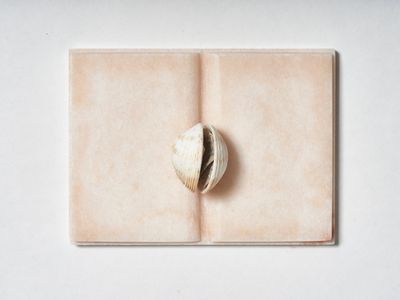
Mirella Bentivoglio at Repetto Gallery
A central figure in the Concrete and Visual Poetry movements in Italy currently being honoured with their first retrospective in Greece at gramma_epsilon, Mirella Bentivoglio was represented by a few sculptures from the 1990s and a historical work on paper from 1972 at miart.
In Untitled (Libro con conchiglie) (1990), a large shell is poised at the centre line of an open rose marble book, while in Untitled (Libro fossile), made in 2011 just six years before the artist passed away, a petrified mollusc rests on another marble tome.
Born to Italian parents in Austria in 1922, Bentivoglio grew up in Milan, studying in Switzerland and London before World War II forced her to learn from home. This eclectic education seems to have influenced a practice that avoided the heavy handedness defining the practices of some of the artist's contemporaries, with simple gestures exploding the poetics of the everyday.
In the 1971 print Amputazione (Amputation), for example, the printed text 'Freude'—German for joy—is repeated below with the 'e' removed, as if to pose 'Freud' as its opposite, while the 1998 photomechanical print on paper shows an installation Bentivoglio made in Bassano, in which she formed the shape of an open book from soil, hence the title Libro campo (Field Book).
Simone Fattal at kaufmann repetto
With a series of roughly hewn humanoid bronze and clay figures on view for Simone Fattal's current show at Whitechapel Gallery in London, it made sense to see a series of smaller figures, defined by surfaces that hold their maker's marks in Milan.
Fattal's Whitechapel show extends an institutional run, from a lauded survey at MoMA's PS1 (Works and Days, 31 March–2 September 2019) in 2019, and A breeze over the Mediterranean staged at ICA Milano in 2021, held in partnership with the commissioning and research programme 'Pompeii Commitment. Archaeological Matters' (8 September 2021–9 January 2022).
The ICA Milano show, Fattal's first in Italy, featured ceramics the artist created at Officine Gatti of Faenza, based on research and site visits to Pompeii, which Fattal described as a place destroyed not by the passage of time, but by a single moment.
'Ruins in the world can be read on many levels, but there are fragments of all periods mingled together, or on top of each other, you have to reconstruct the influences, the sequence in time,' Fattal observed. 'In Pompeii, it's a fixed image.'2
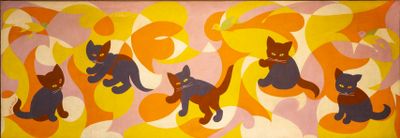
Giacomo Balla at Galleria d'Arte Maggiore g.a.m.
Bonus highlight here for Giacomo Balla, an un/problematic fave, whose affiliation with Futurism—and its complicated association with fascism—was apparently cut in 1937, when Balla reportedly sent a letter to the newspaper Perseo and dissociated himself from the movement.
Before then, Balla had become something of a leading light in this new wave of artistic energy that celebrated technology and war. He signed the Manifesto of Futurist Painters in 1910, which built on the 1909 Futurist Manifesto written by the movement's founder Filippo Marinetti, who went on to found the Futurist Political Party in 1918, only to merge with Mussolini's 'Italian Fasces of Combat' and co-write the Fascist Manifesto a year later.
With that in mind, Balla's Canaringatti – Gattifuturisti, a landscape-format canvas from 1923–1924 depicting five adorable black cats prancing over a flurry of yellow, pink, and orange flourishes, was a striking vision when thinking about the overlaps between the techno-evangelism of now and yesteryear. Perhaps an analogue version of the internet cat phenomenon, and a harbinger of what lies behind the fluff. —[O]
1 Ruben Modigliani, 'Agostino Iacurci, a Technicolor world', Interior Furniture Design Magazine, 31 March 2022, https://ifdm.design/2022/03/31/agostino-iacurci-a-technicolor-world/
2 Exhibition press release, Simone Fattal. A breeze over the Mediterranean, ICA Milano (8 September 2021–9 January 2022), https://www.icamilano.it/en/special-projects/simone-fattal-breeze-over-mediterranean

